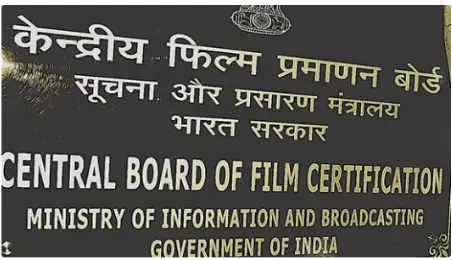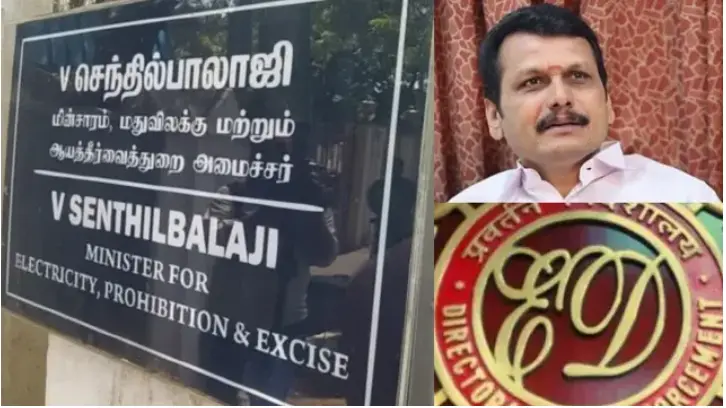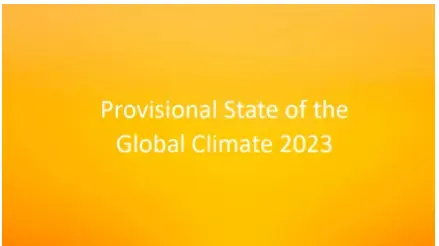Thursday, 28th March 2024
Cotton Candy Banned
In News: Himachal Pradesh has recently imposed a one-year prohibition on the manufacturing, distribution, and retention of Cotton Candy or Candy Floss due to the discovery of Rhodamine B, a potentially dangerous coloring agent.

What is Cotton Candy?
- Cotton candy, also known as candy floss or fairy floss, is a sugary confectionery typically found at carnivals and fairs.
- It's created by liquefying sugar and spinning it through small holes, where it solidifies into thin strands.
- These strands are collected onto a cone or stick, resulting in a fluffy, cotton-like texture.
What is Rhodamine B?
- Rhodamine B is a dye commonly used in industries like textiles and leather for its vibrant coloring properties.
- Despite its low cost, it's unfit for consumption and can cause acute toxicity and irritation to the eyes and respiratory tract.
- While not classified as carcinogenic to humans by the World Health Organization, studies on rats have shown potential carcinogenic effects.
- Its illegal addition to food items such as gobi manchurian and cotton candy is primarily seen among small roadside vendors in smaller cities due to a lack of awareness about its harmful effects.
- The Food Safety and Standards Authority of India (FSSAI) has explicitly banned its use in food products.
Allowed Food Colors by the Food Safety Act, 2006
- Natural Food Colors
- Carotene and carotenoids: Natural pigments found in fruits and vegetables like carrots and tomatoes, responsible for yellow, orange, and red hues.
- Chlorophyll: Derived from plants, particularly responsible for green coloration.
- Riboflavin: Known as vitamin B2, contributing to yellow coloring in various foods.
- Caramel: Produced by heating sugar, offering a range of colors from pale yellow to deep brown.
- Annatto: Extracted from achiote seeds, imparting an orange-red hue and commonly used in dairy products.
- Saffron: A costly spice known for its intense yellow color.
- Curcumin: Derived from turmeric, providing a yellow coloration.
- Synthetic Colors
- Ponceau 4R, carmoisine, erythrosine: Synthetic red colors.
- Tartrazine, sunset yellow FCF: Synthetic yellow colors.
- Indigo carmine, brilliant blue FCF: Synthetic blue colors.
- Fast green FCF: Synthetic green color.
What is the Food Safety and Standards Authority of India?
- FSSAI is an autonomous body established under the Food Safety and Standards Act, 2006, consolidating various food-related laws.
- It aims to regulate and supervise food safety and quality in India, operating under the Ministry of Health & Family Welfare.
- FSSAI's functions include framing regulations, granting licenses, enforcing laws, conducting surveillance, and promoting food fortification and hygiene.
- It conducts various events and campaigns like World Food Safety Day, Eat Right India, and RUCO (Repurpose Used Cooking Oil) to raise awareness about food safety and hygiene.
|
UPSC Previous Year Questions Prelims (2018) Q. Consider the following statements:
Which of the statements given above is/are correct? (a) 1 only Ans: (a) Mains (2021) Q.1 Elaborate the policy taken by the Government of India to meet the challenges of the food processing sector. |
Source: TOI
River Basin Management
In News: A recent report by the Kathmandu-based ICIMOD and the Australian Water Partnership highlights the necessity of multilateral treaties for integrated management of the Indus, Ganga, and Brahmaputra rivers.
Key Highlights of the Report
- Emphasis on Integrated River Basin Management: The report underscores the significance of adopting an integrated approach to river basin management, involving collaboration among stakeholders and sharing quality data on water availability, biodiversity, and pollution.
- Advocacy for Multilateral Treaties: Despite existing bilateral agreements, the absence of multilateral treaties for river management poses a challenge. The report stresses the need for such agreements, particularly for managing critical rivers like the Indus, Ganga, and Brahmaputra.
- Dependence on Critical Rivers: Millions of people in India, Tibet (China), Pakistan, Afghanistan, Nepal, and Bhutan rely on rivers like the Indus, Ganga, and Brahmaputra for sustenance. This dependence highlights the necessity for comprehensive management strategies.
Recommendations
- Leveraging Local Knowledge: Local communities' knowledge should be recognized and utilized for effective crisis management in river basins.
- Empowerment of Communities: Providing resources and technology to local communities can enhance their resilience and involvement in river basin management.
- Addressing Data Gaps: Efforts should be made to fill data gaps related to water availability, biodiversity, and pollution to facilitate better management and early warning systems.
- Holistic Research Approach: Adopting a holistic 'whole basin' research approach is vital, enabling data-sharing, strategic planning, understanding climate change impacts, and ensuring reliable water supply.
- Promotion of Hydro-Solidarity: Promoting cooperation and solidarity among nations regarding water resources management is essential for addressing transboundary water issues effectively.
Key Facts About the Ganga, Indus, and Brahmaputra River Basins
Ganga River Basin
- Source and Headwaters: Originating from the Gangotri Glacier, the Ganga traverses through several states in India and enters Bangladesh before flowing into the Bay of Bengal.
- Major Tributaries: Tributaries like the Yamuna, Gomti, and Ghagra contribute significantly to the Ganga's flow.
- Delta and Outflow: The Ganga merges with the Brahmaputra in Bangladesh, forming the Padma River, which eventually flows into the Bay of Bengal.
Indus River Basin
- Source: Originating in Tibet, the Indus flows through India and Pakistan, serving as a lifeline for millions of people.
- Major Tributaries: Tributaries like the Jhelum, Chenab, and Ravi are vital for agriculture and water supply in the region.
- Delta and Outflow: The Indus empties into the Arabian Sea near Karachi, forming the vast Indus Delta.
Brahmaputra River Basin
- Source: Originating in Tibet, the Brahmaputra flows through India and Bangladesh, supporting agriculture and hydropower generation.
- Major Tributaries: Tributaries like the Subansiri and Kameng contribute to the Brahmaputra's flow.
- Delta and Outflow: The Brahmaputra joins the Ganga in Bangladesh, forming the Padma River, which flows into the Bay of Bengal.
|
UPSC Previous Year Questions Prelims (2021) Q. With reference to the Indus river system, of the following four rivers, three of them pour into one of them which joins the Indus directly. Among the following, which one is such a river that joins the Indus direct? (a) Chenab (b) Jhelum (c) Ravi (d) Sutlej Ans: (d) |
Source: IE
Patents (Amendment) Rules, 2024
In News: The Ministry of Commerce and Industry has recently issued the Patents Amendment Rules, 2024, introducing significant alterations to Indian patent practice and procedure.
Key Changes Introduced Under Patents (Amendment) Rules, 2024
- Reduced Timeline for Request for Examination (RFE)
- The timeframe for filing the RFE has been shortened from 48 months to 31 months from the priority date.
- This adjustment aims to expedite the patent examination process.
- Simplified Submission of Form 3
- Applicants now have the option to file a single updated Form 3 after receiving the First Examination Report (FER), streamlining the process.
- Introduction of ‘Certificate of Inventorship’
- A new provision for issuing a ‘Certificate of Inventorship’ has been introduced to acknowledge inventors' contributions to patented inventions.
- This addresses the previous lack of inventor identification on Indian patent certificates.
- Frequency of Filing Statements
- The frequency of submitting working patents has been modified from once in a financial year to once in every three financial years.
- Amendments in Pre-grant and Post-grant Opposition Procedures
- Adjustments have been made to the timeframes for submission of recommendations by an Opposition Board and response times for applicants.
- Additionally, the amendment permits filing a divisional application concerning an invention disclosed in the provisional or complete application, aligning with a recent court decision clarifying divisional application criteria.
|
UPSC Previous Year Questions Prelims (2019) Q. With reference to the ‘National Intellectual Property Rights Policy’, consider the following statements:
Which of the above statements is/are correct? (a) 1 only (b) 2 only (c) Both 1 and 2 (d) Neither 1 nor 2 Ans: (c) Q How does the National Biodiversity Authority (NBA) help in protecting Indian agriculture?
Which of the statements given above is/are correct? (a) 1 only (b) 2 and 3 only (c) 1 and 3 only (d) 1, 2 and 3 Ans: (c) Mains (2014) Q. In a globalized world, Intellectual Property Rights assume significance and are a source of litigation. Broadly distinguish between the terms—Copyrights, Patents and Trade Secrets. |
Source: Lexology
What is the New Collective Quantified Goal?
In News: Climate experts anticipate that the upcoming climate change conference in Baku, Azerbaijan (COP 29, scheduled for November 11-24), will center its focus on financial matters.

Background
- COP 27 (2022 Climate Change Conference)
- Established a Loss and Damage Fund to aid developing nations in recovering from climate disasters.
- COP 28 (Dubai Conference 2023)
- Focused on the Global Stocktake (GST), highlighting the necessity of transitioning away from fossil fuels and tripling global renewable energy capacity by 2030.
- COP 29 (Baku, Azerbaijan)
- Expected to prioritize discussions on climate finance.
New Collective Quantitative Goal (NCQG)
- Definition and Importance
- Refers to the additional funding required annually by wealthy nations from 2025 to support climate action in poorer countries.
- Essential for developing nations to combat climate change effectively.
- Current Status
- Recent minister-level climate meeting in Copenhagen finalized some technical aspects regarding NCQG.
Financial Requirements for Climate Action
- Assessments by UNFCCC Secretariat
- Estimated total annual requirement of about $6 trillion for developing countries to implement climate action plans until 2030.
- Updated report expected to raise this figure significantly.
- Global Transition to Low-Carbon Economy
- Estimated need for $4-6 trillion annually until 2050.
Challenges in Climate Financing
- Availability of Finance
- Major obstacle to scaling up global climate action, particularly in developing countries.
- Current climate finance flows fall short of the promised $100 billion annually since 2020.
- Skewed Allocation
- Current finance flows predominantly favor mitigation actions, while developing countries advocate for increased funding for adaptation and other activities.
India's Position on Climate Financing
- Demand for Funding
- India calls for developed countries to provide at least $1 trillion per year in climate finance to developing countries from 2025, emphasizing grants and concessional finance.
- G-20 New Delhi Leader's Declaration
- Recognizes the substantial financial requirements for transitioning to a renewable energy-driven economy, citing a need for $5.8-5.9 trillion in the pre-2030 period.
Conclusion
- Negotiated Approach
- Unlike the unilateral $100 billion figure, the NCQG will be the result of negotiations, allowing countries better control over compliance.
- Distribution of Funds
- The allocation of the new sum across various needs like mitigation, adaptation, and loss and damage will play a crucial role in the battle against climate change.
Source: IE
Krishi Integrated Command and Control Centre
In News: Recently, the Union Agriculture Minister inaugurated a Krishi Integrated Command and Control Centre (ICCC) established at Krishi Bhavan in New Delhi.
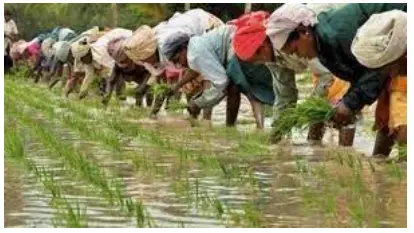
About Krishi Integrated Command and Control Centre
- Definition: It is a technology-driven solution housed within the Ministry of Agriculture & Farmers’ Welfare to facilitate informed decision-making.
- Objectives: It aims to comprehensively monitor the agricultural sector by consolidating geospatial information from various sources, including remote sensing, soil surveys, and weather data from the India Meteorological Department (IMD).
- Working: The center employs cutting-edge technologies such as artificial intelligence, remote sensing, and Geographic Information Systems (GIS) to gather and process extensive data on factors like temperatures, rainfall, wind speed, crop yields, and production estimates. This data is then presented graphically.
Features of the Centre
- Crop Information: Provides insights into crop yields, production, drought situations, and cropping patterns through map, timeline, and drill-down views.
- Data Analysis: Offers analysis of trends, outliers, Key Performance Indicators (KPIs), and feedback on agricultural schemes, programs, projects, and initiatives.
- Platforms Used: Utilizes platforms like the Krishi Decision Support System (DSS) to collect micro-level data and present a macro view.
- Individual Farmer Advisories: Facilitates the generation of farmer-specific advisories through apps like Kisan e-mitra, leveraging AI and machine learning algorithms. This involves identifying farmers through their mobile numbers or Aadhaar, matching them with field information from land records and historical crop sowing data, and delivering customized advisories in local languages using the Bhashini platform.
Source: IE
ICGS Samudra Paheredar
In News: The Ministry of External Affairs recently conducted a visit to the Indian Coast Guard ship Samudra Paheredar, currently deployed in Manila Bay, Philippines, as part of its overseas deployment to ASEAN countries.

About ICGS Samudra Paheredar
- ICGS Samudra Paheredar is a specialised Pollution Control Vessel (PCV) operated by the Indian Coast Guard.
- It is India's second PCV, following ICGS Samudra Prahari.
- The vessel was constructed domestically by ABG Shipyard in Surat.
- Commissioned in 2012, it is stationed on the East Coast of India in Vishakhapatnam, Andhra Pradesh.
Features
- The ship measures 94.10 meters in length, with a maximum displacement of 4,300 tons, and is powered by 3,000-kilowatt twin diesel engines.
- It can reach a maximum speed of 21 knots, supported by twin shaft generators, and has an endurance of 6,500 nautical miles at economical speed, enabling it to remain at sea for up to 20 days.
- Primarily designed for pollution response at sea, it is equipped with advanced pollution response and control equipment, including containment gear like hi-sprint booms and river booms, recovery devices like skimmers, and side sweeping arms.
- The vessel has a storage capacity of 502 kilolitres, facilitating unhindered oil-recovery operations.
- Special features include an integrated platform management system, a power management system, and a high-powered external firefighting system.
- It has the capability to accommodate one twin-engine ALH/Chetak helicopter for aerial operations.
Source: ET
About Magnetofossils
In News: In the depths of the Bay of Bengal, researchers have unearthed a colossal magnetofossil embedded within a 50,000-year-old sediment, marking it as one of the most recent discoveries of its kind.
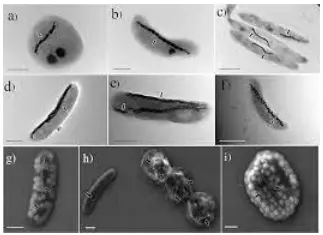
Overview of Magnetofossils
Magnetofossils are fossilized remnants of magnetic particles formed by magnetotactic bacteria, also known as magnetobacteria, found preserved within geological records.
Characteristics of Magnetotactic Bacteria
- Magnetotactic bacteria are primarily prokaryotic organisms that align themselves along the earth’s magnetic field.
- Traditionally, these bacteria were thought to navigate using the magnetic field to reach locations with optimal oxygen levels.
- They contain unique structures rich in iron, resembling compasses, stored within small sacs.
- These bacteria produce tiny crystals composed of iron-rich minerals like magnetite or greigite, aiding them in navigating varying oxygen levels in their aquatic habitats.
Findings of the Study
- Analysis of a three-meter-long sediment core from the southwestern Bay of Bengal revealed primarily pale green silty clays.
- Abundant benthic and planktic foraminifera, single-celled organisms with shells, were discovered near the sea bed and in free-floating water.
- Microscopy confirmed the presence of both conventional and giant magnetofossils within the sediment sample.
- The Bay of Bengal, particularly at depths of 1,000-1,500 meters, exhibited notably low oxygen concentrations.
- Fluctuations in monsoon activity were detected through analysis of magnetic mineral particles from distinct geological periods.
- Rivers such as the Godavari, Mahanadi, Ganga-Brahmaputra, Cauvery, and Penner, draining into the Bay of Bengal, played a significant role in magnetofossil formation.
- Nutrient-rich sediment transported by these rivers, combined with reactive iron and organic carbon in suboxic conditions, created a favorable environment for magnetotactic bacteria growth.
- Freshwater discharge from rivers, along with oceanographic processes like eddy formation, contributed to oxygen levels uncommon in typical low-oxygen zones.
- The presence of magnetofossils suggests prolonged suboxic conditions in the Bay of Bengal, facilitating the thriving of magnetotactic bacteria over an extended period.
Source: TH
National Assessment and Accreditation Council
In News: In a recent executive council meeting, the National Assessment and Accreditation Council (NAAC) resolved to transition from the letter grade system to a binary categorization of "accredited" or "not accredited" for higher educational institutions.
Overview of the National Assessment and Accreditation Council (NAAC)
- NAAC is an autonomous body operating under the University Grants Commission (UGC), falling under the purview of the Ministry of Human Resource Development (MHRD).
- Its establishment in 1994 was in alignment with the directives outlined in the National Policy of Education, 1986, and the Programme of Action (POA), 1992, emphasizing the evaluation of higher education quality in India.
- Headquartered in Bengaluru, NAAC undertakes the evaluation, assessment, and accreditation of Higher Education Institutions (HEIs) across the country.
- Assessment involves performance evaluation based on self-study and peer review using predefined criteria.
- Accreditation granted by NAAC is valid for five years and signifies certification of quality.
- Institutions are rated on a scale from A++ to C, with a grade of D indicating non-accreditation.
- HEIs eligible for assessment must have at least two batches of graduates or be operational for six years, meeting specified conditions.
- The process of Assessment and Accreditation (A&A) by NAAC is presently voluntary.
- NAAC bases its assessment on seven criteria: Curricular aspects, Teaching-learning and evaluation, Research, Consultancy and extension, Infrastructure and learning resources, Student support and progression, Governance and leadership, and Innovative practices.
- The governing structure of NAAC comprises the General Council (GC) and Executive Committee (EC), featuring educational administrators, policymakers, and senior academicians.
- The Chairperson of the UGC serves as the President of the NAAC GC, while an eminent academician nominated by the President of the GC leads the EC.
- The Director, serving as the academic and administrative head, also functions as the member-secretary of both the GC and EC.
- NAAC receives guidance from advisory and consultative committees formed periodically.
Source: IE
Armed Forces (Special Powers) Act (AFSPA)
In News: Recently, the Union Home Minister announced that the central government would contemplate the possibility of repealing the Armed Forces (Special Powers) Act in Jammu and Kashmir.
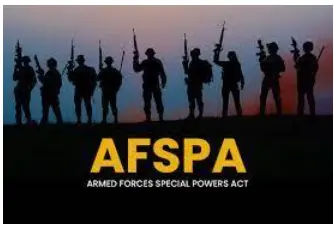
About Armed Forces (Special Powers) Act (AFSPA)
- AFSPA is a legislation enacted by the Parliament in 1958, granting special powers and immunity to the armed forces to maintain public order in "disturbed areas".
- Application: It can only be enforced after an area has been declared "disturbed" under section 2 of the Act.
- Definition of a Disturbed Area: An area may be considered disturbed due to differences or disputes among various religious, racial, linguistic, or regional groups, or castes and communities.
- Declaration Authority: The Central Government, State Governor, or Union Territory administrator holds the authority to declare the whole or part of a State or Union Territory as a disturbed area.
- Invocation: It can be invoked in areas where "the use of armed forces in aid of civil power is necessary".
- Special Powers Granted:
- Authority to prohibit gatherings of five or more persons and to use force, including opening fire, after issuing a warning if individuals are believed to contravene the law.
- Power to arrest individuals without a warrant based on reasonable suspicion, enter or search premises without a warrant, and prohibit possession of firearms.
- Arrested individuals may be handed over to the nearest police station along with a detailed report on the circumstances leading to the arrest.
- Immunity from prosecution for armed forces personnel unless sanction is granted by the Union Government to prosecuting agencies.
- Areas of Enforcement: AFSPA is currently in force in Jammu and Kashmir, Assam, Manipur (except Imphal), and Arunachal Pradesh, besides Nagaland.
Source: NDTV
Black Carbon - Edukemy Current Affairs
In News: As per a study conducted in 2016, the residential sector accounts for 47% of India's overall black carbon emissions.
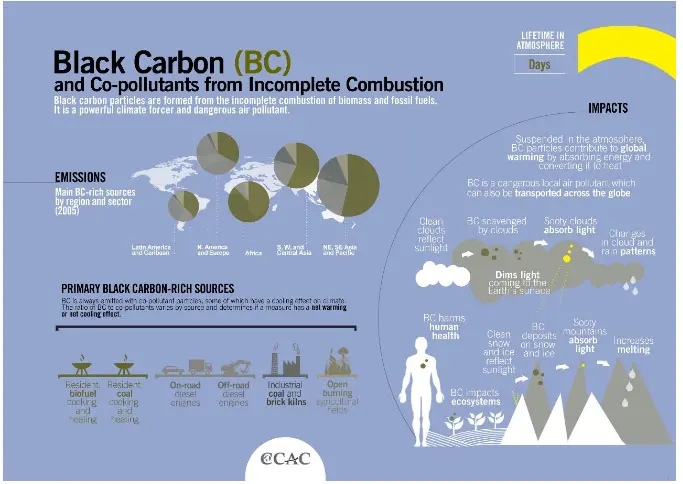
About Black Carbon
- Black carbon is a dark, sooty substance emitted alongside other pollutants during incomplete combustion of biomass and fossil fuels.
- It constitutes a significant portion of particulate matter (PM), a known air pollutant.
- This substance is classified as a short-lived climate pollutant, remaining in the atmosphere for only days to weeks after release.
- Black carbon plays a crucial role in warming the atmosphere by efficiently absorbing light and converting it into heat.
- Additionally, it affects cloud formation and influences regional precipitation patterns.
- When deposited on ice and snow, black carbon reduces surface albedo, leading to increased absorption of sunlight and surface heating.
Impacts
- Black carbon contributes significantly to global warming and poses various health risks, including heart disease, birth complications, and premature death.
- Its warming impact on climate is estimated to be 460-1,500 times stronger than that of CO2.
- In India, the majority of black carbon emissions result from the combustion of biomass in traditional cookstoves, such as those fueled by cow dung or straw.
Source: TH
Empowering Voters
In News: The efforts of the Association of Democratic Reforms (ADR) and Common Cause, petitioners in the Electoral Bonds case in the Supreme Court, deserve commendation for their role in uncovering the unethical ties between political parties and businesses.
Role of Money in Politics
- Political parties often resort to opaque methods to extract funds from businesses, leading to quid-pro-quo situations.
- Money's influence in politics often deters common people from participating, allowing individuals with ill-gotten wealth to dominate.
- Notably, the assets of many re-elected MPs have surged threefold, underscoring the significance of financial power in politics.
Criminalisation of Politics
- Legislatures at both parliamentary and state levels are populated with individuals facing criminal charges, irrespective of party affiliations.
- A significant percentage of legislators across India have criminal cases against them, raising concerns about the integrity of the political system.
- Despite widespread criminal involvement in politics, voters often elect candidates with tainted backgrounds.
Voting Behavior and Governance Issues
- Studies suggest that voters may support criminal candidates due to perceived effectiveness in fulfilling election promises.
- Limited access to information and reliance on factors like ethnicity or religion contribute to voters' decisions.
- Efforts to educate voters about candidates' criminal backgrounds have been made, but their effectiveness remains a challenge.
Reforms Taken
- Legal measures have been implemented to disqualify convicted legislators and restrict their appointment to ministerial positions.
- The Supreme Court and Election Commission have issued directives for political parties to disclose candidates' criminal histories.
- However, compliance with these directives remains inconsistent.
Effectiveness of Information Provision - Study Findings
- A study conducted during UP assembly elections aimed to gauge the impact of informing voters about candidates' criminal backgrounds via mobile messaging.
- Results showed a decrease in support for candidates with criminal charges and an increase in voter turnout when provided with information.
- The study highlights the importance of actively informing voters about candidates' backgrounds to influence voting behavior.
Way Forward - Lessons Learned
- Merely making information public is insufficient; active dissemination to voters is crucial, especially in a country with limited internet literacy.
- Utilizing mobile messaging platforms for voter education proves to be effective, efficient, and cost-friendly.
- Displaying candidate information at election booths further enhances voter awareness and empowerment.
Conclusion
By empowering voters with knowledge about candidates, the political system can be cleansed of corruption and criminality, paving the way for a more transparent and accountable governance structure.
Source: TS
Share the article
Edukemy’s Current Affairs Quiz is published with multiple choice questions for UPSC exams
MCQ
Get Latest Updates on Offers, Event dates, and free Mentorship sessions.

Get in touch with our Expert Academic Counsellors 👋
Frequently Asked Questions
UPSC Daily Current Affairs focuses on learning current events on a daily basis. An aspirant needs to study regular and updated information about current events, news, and relevant topics that are important for UPSC aspirants. It covers national and international affairs, government policies, socio-economic issues, science and technology advancements, and more.
UPSC Daily Current Affairs provides aspirants with a concise and comprehensive overview of the latest happenings and developments across various fields. It helps aspirants stay updated with current affairs and provides them with valuable insights and analysis, which are essential for answering questions in the UPSC examinations. It enhances their knowledge, analytical skills, and ability to connect current affairs with the UPSC syllabus.
UPSC Daily Current Affairs covers a wide range of topics, including politics, economics, science and technology, environment, social issues, governance, international relations, and more. It offers news summaries, in-depth analyses, editorials, opinion pieces, and relevant study materials. It also provides practice questions and quizzes to help aspirants test their understanding of current affairs.
Edukemy's UPSC Daily Current Affairs can be accessed through:
- UPSC Daily Current Affairs can be accessed through Current Affairs tab at the top of the Main Page of Edukemy.
- Edukemy Mobile app: The Daily Current Affairs can also be access through Edukemy Mobile App.
- Social media: Follow Edukemy’s official social media accounts or pages that provide UPSC Daily Current Affairs updates, including Facebook, Twitter, or Telegram channels.

